Fishing with Lures
The world of artificial lures may seem endless, but the methods for fishing with them are relatively similar. Remember that artificial fishing lures are meant to mimic baitfish, so the way in which you fish with them should do the same. Consider the fishing techniques below.
Bottom Bouncing
Bottom bouncing is done from a drifting or trolling boat, and it’s a great way to attract or locate fish during most seasons and times of day.
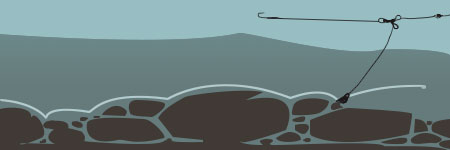
BOTTOM BOUNCING: BASICS
Bottom bouncing, a modified form of drift fishing or trolling, is an effective way to attract fish and cause them to strike or start feeding. Using buck tail jigs or natural baits, bottom bouncing is usually done from a moving boat (drifting or using a trolling motor) by dragging the bait or lure along the bottom, causing it to bounce along raising puffs of sand or mud. This is also an excellent method for locating fish if you are not familiar with the waters.
BOTTOM BOUNCING: STEPS
- Use a buck tail jig or natural bait and drag it along the bottom.
- Drag the lure to bounce along stirring up small clouds of sand or mud.
- After a few strikes with bottom bouncing, you can drop anchor and apply other methods such as still fishing, jigging, or casting to hook the particular kind of species you’ve attracted.
- Remember to check the bait frequently for weeds and other debris that may be picked up as it moves along the bottom.
Trolling with Lures
Trolling with lures is one of the more popular fishing methods while boating, trolling drags lures behind, usually a good way back, while the boat moves forward slowly.

TROLLING WITH LURES: BASICS
Trolling is a method of fishing where one or more fishing lines with lures or bait fish are drawn through the water. This may be behind a moving boat. The motion of the boat imparts action on the lures, whether they are spoons lures, surface lures, plugs, swimbait or spinnerbait. Trolling with lures is one of the most popular fishing methods for catching big game fish such as tuna and marlin.
The depth of the lure depends on their weight, how much line has been let out, the diameter and type of fishing line being used, and the speed at which you are trolling. In addition, some lures have a lip which makes them dive when pulled through the water. The names of such lures might reference the designed depth.
SALTWATER TROLLING
Trolling in saltwater is a good way to present baits and lures to pelagic fish by imitating a swimming baitfish or triggering the natural instincts of a fish to strike. When saltwater trolling, anglers will typically put out anywhere between two and nine lines with trolling lures staggered at various distances from the boat. Although there is no one universal trolling speed, most boats will typically troll natural baits like rigged ballyhoo, mullet, and mackerel, at speeds of 4-7 knots depending on sea conditions. Artificial trolling lures and plugs can be trolled at faster speeds of around 7-9 knots.
Surface Poppers
Surface poppers are a style of topwater fishing bait that get their action from a cupped face carved or molded into the front of the lure body.

A surface popper is a fishing lure that comes in a variety of sizes and colors. Surface poppers are used in surface popping technique. Poppers have a cupped face at the front of the lure which is designed to push out a surge of water on its retrieval. In contrast to trolling, surface poppers will allow you to interact more with your catch.
SURFACE POPPING TECHNIQUE: STEPS
There’s nothing quite like the sudden, exciting rush of a fish rising to the surface and exploding onto your lure.
- Cast your popper out to the target area and let it settle briefly.
- Take in small amounts of line slowly, the cupped face “pops” along the surface will imitate the action of prey, such as small insects, small frogs or even a small injured fish.
- To increase your chances of landing your catch, resist the urge to set the hook immediately when the fish strikes – let it take the popper under the water first – then set your hook firmly.
Fishing with Spoons
Fishing spoons are among the most popular lures and are easy to use.
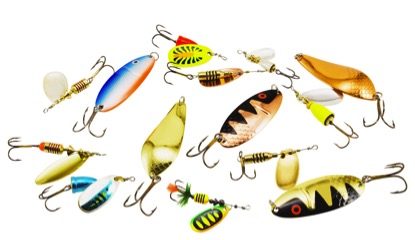
FISHING SPOONS: BASICS
Fishing spoons have a simple design, an oblong shape, concave on one side that catches water producing a wobble and light reflection flash imitating a fleeing or crippled bait fish. Spoons work best for larger fish species such as northern pike, largemouth bass, muskies, walleye, salmon and trout.
The action of the spoon is based on its shape and thickness. A long spoon will display a wider side to side wobble than a shorter spoon. A deep concave spoon will also produce a wider wobble that a flatter spoon.
FISHING SPOONS: TYPES
Some fishing spoons are thin and light, others are thick and heavy. Different fishing spoons have different actions. How and where you’re fishing will determine how to use them.
Casting spoons:The basic technique is to cast it out and reel it back. A steady retrieve is usually best. If fish are curious but not striking, try slight variations in the speed or direction of your spoon.
Trolling spoons:Thinner and lighter than casting spoons so they can be trolled slowly. Typically used with depth control rig for open water species like trout, salmon or walleye. Can also be tied onto a rig with a diving crankbait and trolled on a long line to go after species near the bottom.
Topwater/Weedless spoons:Great for predators like bass, musky and pike that tend to hide in thick underwater cover. Cast over the cover, start retrieving and reel just fast enough to keep the lure on the surface.
Jigging spoons:Great for predators typically found on deep structure. Let the spoon freefall down. When it hits bottom, take up slack line until the rod tip is a foot above the water, then work the spoon with short jerks up and down. Usually, strikes occur when the spoon is falling, so be ready.
Jigging
Jigging is one of the best fishing techniques when teaching someone new how to fish.
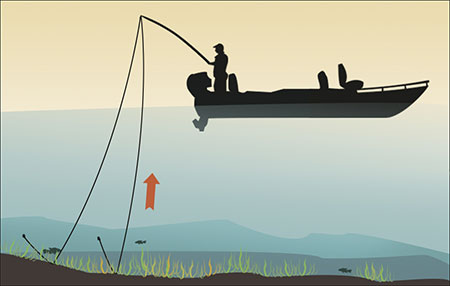
JIGGING: BASICS
Jigging it is also one of the most active fishing methods, requiring you to snap or pop the rod tip up quickly to move the lure vertically in the water column. You can jig straight up and down as you drift, or cast the lure out and jig it back towards you horizontally while reeling. Jigging a lure or bait creates the look of an injured baitfish that a game fish would want to bite.
Jig rigs come in all sizes, shapes and colors, and can be used with or without live fishing bait. Many spoons are designed for jigging — they flutter as they fall enticing a fish. Soft plastic worms are also used for jigging as are painted lead-headed hook and feather combo jigs called buck tails.
Tip: If you are casting a jig out and retrieving while jigging, you’ll need to reel in slowly to keep the jig near the bottom.
JIGGING: STEPS
If you are learning how to fish by jigging, here are some simple steps:
- Cast out and let your jig hook sink to the bottom.
- Count a few seconds or wait until you feel the spoon hit the bottom
- Snap or pop your wrist and rod tip up quickly a short distance
- Let the lure drop back to the bottom
- You can jig up and down, side to side or up and down and sideways.
- Reel down a little bit to keep the line tight in case of a strike
- Repeat
SALTWATER JIGGING
Jigging lures, or 'jigs,' are some of the most versatile lures in that can be used in just about any place you find fish. Jigs comes in all shapes, colors, styles and weights and can be fished in a variety of different manners so that they mimic baitfish. The two most common jigs are probably the bucktail jig and the vertical jig.
A bucktail jig will typically consist of a lead head, that can be a variety of different shapes and sizes, which is molded onto a hook and has hair-like material tied to the bottom of the jig head. This hair-like material is where the name 'bucktail' comes from because many bucktail jigs are made using hair from a deer. The bucktail hair and jighead come in a variety of different colors. These bucktail jigs can be fished by themselves or they can be rigged with a rubber worm, live shrimp or other natural baits like strips of fish.
A vertical jig, or speed jig, is made of a long and slender piece of lead or metal that cuts through the water mimicking an injured baitfish. Vertical jigs will have one or more dangling hooks attached to a split ring which can be attached to the top or the bottom of the jig. Vertical jigs range anywhere from 1/8oz up to 14oz and are also referred to as "butterfly jigs."
When fishing with jigs, it is important that the angler constantly jig the lure up and down by constantly lifting the rod tip up and down. A good method for jigging is to drop the jig all the way down to the bottom and with a very rapid retrieval, twitch the rod tip erratically until the jig comes to the surface and repeat. No matter which type of jig you are using, it is important to match the weight of each jig to the depth at which you are fishing. Deeper water will require heavier jigs to reach the bottom. It is also important to take the tides and current into consideration when choosing your jig weight.
Cast and Retrieve
Use whatever lure you want, a swimbait, a crankbait, a spinner — they all are designed to be tossed out, and reeled back in using a particular motion, this is called cast and retrieve.
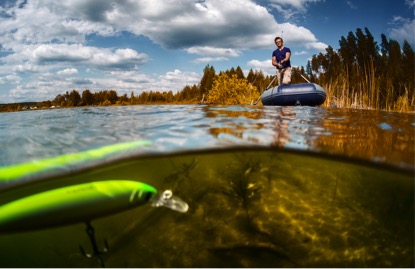
CAST AND RETRIEVE: BASICS
This fishing technique can cover a lot of water quickly as the motion is mostly horizontal. The speed at which you reel to retrieve the lure, the angle at which you hold the rod and the design of the lure all impact the depth of the lure on the way back.
Many hard swimming lures have a lip at the front that helps dive the lure to a particular depth. Many are available in deep, or shallow running versions. Soft plastic minnows, or curly-tailed worms can also be used.
CAST AND RETRIEVE: STEPS
- Cast your lure to your target – remember fish love structure or cover.
- Let the lure fall to your desired depth.
- Retrieve the lure by reeling in, using your line to pull the lure to mimic a swimming fish. You may wish to vary the speed of your retrieve to find a speed that entices a bite.
- Wait a couple seconds, then cast again.
- Repeat the retrieval.
Topwater Fishing
Topwater fishing is a variation on cast and retrieve that uses a floating lure.
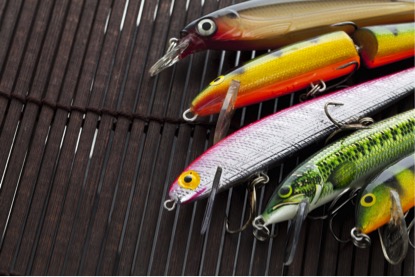
TOPWATER FISHING: BASICS
Fish respond very differently to top-water lures. Smooth water usually calls for a quiet and gentle presentation while choppy water requires anglers to make a statement. Swim a slider or a soft plastic erratically around rocks, edges, deadfall, or weeds but aggressively chug a popper around the same type of water when a strong wind creates a chop. If it ain’t working, try experimenting with a different approach.
TOPWATER FISHING: STEPS
- You can use topwater fishing lures such as poppers, which have a concave face that makes a big splash when you jerk the lure sharply on the surface.
- Cast the lure to your desired location, then reel in using a retrieval motion that mimics a fish’s meal.
- You can also use the “walk the dog” type lures that shake their head back and forth when you just twitch the tip of your rod in a rhythm. This shaking head action mimics a dying baitfish on the surface.